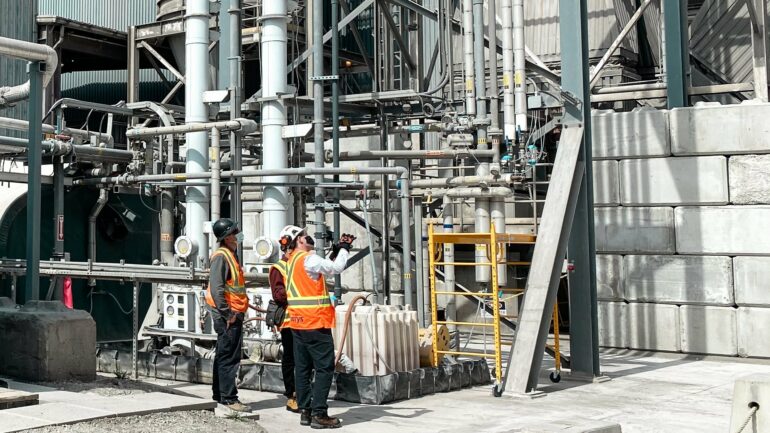Alberta’s world renown in carbon capture and sequestration is set to receive another lift thanks to the promise of a material invented and tested in the province that offers an efficient way to pull carbon dioxide out of industrial emissions.
An team from the University of Alberta’s Faculty of Engineering characterized a CO2-capturing microporous material developed by a group led by George Shimizu at the University of Calgary that attracts gas molecules and sees them stick to its surface. The material, named Calgary framework-20 (CALF-20), belongs to a family of microporous solids called metal-organic frameworks.
Ph.D. student Tai Nguyen and Arvind Rajendran, associate professor in the U of A’s Department of Chemical and Materials Engineering, tested the capabilities of CALF-20 to uncover its unique properties that make it an excellent candidate for CO2 capture. Rajendran explained that the idea behind metal-organic frameworks has been around for decades after researchers began proving that a combination of metals and organic molecules, known as linkers, had the potential of concentrating gases from a mixture.
In the case of CALF-20, a single gram has a surface area of more than 500 square meters. These materials can be packed in a column, much like a catalytic converter, and essentially fastened to the end of a smokestack.
Rajendran likens the process that follows when the emissions are sent through the material to a group of people being sent through a shopping district.
“You will start seeing that the people who don’t like to shop move ahead, whereas those who do will move slower,” he said.
“Initially, the people who don’t like to shop come out first.”
In cases where the emissions are made up of nitrogen and CO2, the nitrogen comes out first while the CO2 is left behind, adhering to the material. To move the CO2 along so the material can be reused, either the pressure in the column is brought down and the concentrated CO2 is vacuumed out, or the system is heated up using waste heat or steam.
“When you provide heat, the CO2 is released and we can start collecting it in a more concentrated form than what you sent in.”
Solving practical problems
The problem with these materials, however, is that while they often work in the controlled confines of a lab, they don’t work in the presence of water or other impurities. That’s where Rajendran’s team stepped in.
“The innovation in this material is that it can handle water nicely. This means you don’t have to dry your gas before you filter it through this material, which reduces the need for a whole bunch of energy,” he said.
Rajendran added that the experiments needed to characterize how materials perform in the presence of water are challenging and laborious: “We had to develop new techniques, and it took the enormous patience of Tai to demonstrate the exceptional ability of CALF-20 to concentrate CO2 even in the presence of water.”
The experiments Rajendran’s team conducted were corroborated by a research team led by Tom Woo at the University of Ottawa using advanced molecular simulations.
Another challenge for carbon-capturing materials is that even the tiniest quantities of emissions byproducts, such as sulfur dioxide and nitrous oxide, can kill the ability of these materials to capture CO2, Rajendran explained.
“The big advantage in CALF-20 is that it works under practical conditions for thousands of hours, where almost all other previous developments did not,” he said.
Once concentrated, the CO2 is either compressed and stored in geological formations, pushed back into old wells for enhanced oil recovery or converted back into fuel, such as methanol, to be used in the creation of other products.
Reducing emissions and costs
Zoramat Solutions, a company based at the University of Calgary, scaled CALF-20 to the multi-kilogram scale, and Innovate Calgary licensed it to Svante, an industry partner out of Burnaby, B.C., that has developed a commercial process. Svante has shown that the material is suitable in an industrial setting and is now testing it in a cement plant at a capacity of one ton per day.
“This is possibly the first large-scale commercialization of a metal-organic framework,” Rajendran said. “These are the next-generation carbon capture technologies that not only reduce CO2 emissions but reduce the cost. These innovations were made possible through multi-institution and interdisciplinary collaborations of synthetic and theoretical chemists, chemical engineers and industry.”
He added the timing coincides with the rollout of provincial initiatives to reduce industry’s environmental footprint, including Canada’s first hydrogen HUB launched in the Edmonton region, backed by more than $2 million in funding from three levels of government. The region is well positioned for success because it has one of the lowest hydrogen production costs in the world, existing experience in hydrogen production, a vast network of pipeline infrastructure, and suitable and existing sites for carbon capture—all of which are necessary to upgrade natural gas into hydrogen for use as a low-carbon fuel.
“In Alberta we sequester close to two to three million tons of CO2 every year and we have become a world leader in this technology because we have some of the biggest demonstration facilities in the entire world,” Rajendran noted.
“The capability to develop new materials, associated processes and scale-up for industrial demonstration asserts Alberta’s position as a world leader in carbon capture and storage.”
The research at the U of A was supported by an Alberta Innovates Strategic Research Program award and an NSERC CREATE grant.
The study, “A scalable metal-organic framework as a durable physisorbent for carbon dioxide capture,” was published in Science.
More information:
Jian-Bin Lin et al, A scalable metal-organic framework as a durable physisorbent for carbon dioxide capture, Science (2021). DOI: 10.1126/science.abi7281
Provided by
University of Alberta
Citation:
Carbon-capturing material could help industry reduce emissions and costs (2021, December 17)



